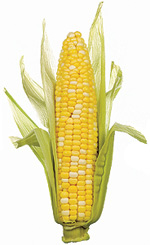 |
Noticed your grocery bills going up? It’s not just your recent taste for chanterelles: Since January 2007, the average price of a dozen eggs in the Midwest went from $1.38 to $2.17. A loaf of bread, $1.01 to $1.26. A gallon of milk, $2.67 to $3.54. The overall Chicago-area food Consumer Price Index increased 4.4 percent, the highest increase since 1996.
The price of food is up nationwide, and it’s moving faster than for other goods. Ephraim Leibtag, a U.S. Department of Agriculture economist, says food prices increased steadily alongside the overall inflation rate for the past two decades, but are now quickly outpacing inflation by at least half a percentage point. (Food accounts for 15 percent of the overall CPI.) It’s tough to point fingers at one particular cause, but economists say the main culprits are the country’s increasing focus on corn-based ethanol, energy costs, and worldwide demand.
The increasing cost to consumers begins on the farm, with higher prices for corn to feed livestock and for gasoline to transport goods. Higher demand for corn to produce ethanol pushes the price up. Of the corn crop, 19 percent—more than two billion bushels—went into ethanol production in 2007, a one-year increase of 30 percent, leading to a price hike from $2 per bushel in 2005 to upwards of $4 per bushel in 2007. (Last year, 330 million bushels of ethanol-bound corn were grown in Illinois, 16.5 percent of the state’s total crop.)
Farmers pass on the increased production costs down the line to wholesalers, grocery stores, and restaurants. Foods with less processing or packaging incur the biggest spike in cost for the consumer, because they are more directly affected by farm costs: the 57 percent jump since January 2007 for eggs in the Midwest, for example (it’s 34.7 percent nationwide).
Some economists say prices should level out eventually. Alternative energy sources should reduce costs to producers. And George Mason University economics professor Tyler Cowen says increased supply from fast-growing countries like China and India will bring prices down.
Until then, consumers will continue to feel a strain on their pocketbooks, with another 3 to 4 percent cost increase projected nationwide for this year. As if you needed another reason to leave that box of Oreos on the shelf.
* * *
By the Numbers
$41.67
Weekly cost of food per person, in median U.S. household (2006)
1:3
Ratio of the cost of the ingredients of a fine dining restaurant meal to its price
1:4
Ratio of the cost of the ingredients of a fast-food restaurant meal to its price
4.9¢
The cost of the corn in an 18-ounce box of corn flakes
$4.35
Cost of an 18-ounce box of Kellogg’s Corn Flakes at the Jewel-Osco in River North
$2
Amount Red Light pays for one diver scallop, up 100 percent from 2007
80¢
Increase per pound—about 8 percent—from January to March 2008 in the amount Naha pays for its Greek feta cheese. The weak dollar and transportation costs are the main reasons.
* * *
How We Compare
Chicago’s food spending is above average for the country, but mostly in line with that of other big cities. Here’s the skinny, using the most recent government data.

Source: U.S. Bureau of Labor Statistics


